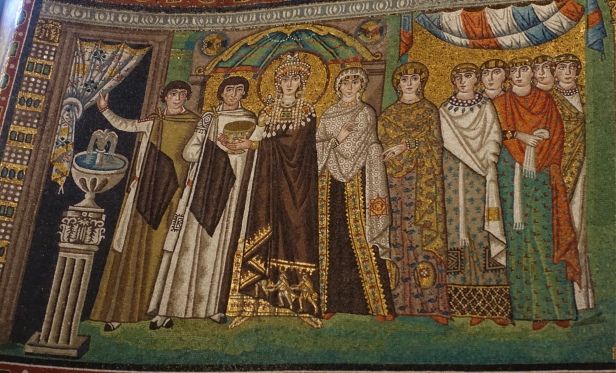I left Casalborsetti walking along a pleasant wooded track parallel to the beach. There was one after another camping ground. The place must be very busy in summer.

I’ve never been passed on a walk by a trotter before !

Here’s your opportunity to buy one of those fishing shacks.

These trees had unusually coloured flowers.

Before long I was walking through an extensive wooded area.

There were horses grazing and jumping courses set up.

A large part of my walk today was spent traversing this pine forest but eventually I came to the outskirts of Ravenna.
This outlet centre looked very impressive but when I passed I saw that it was a bit run down and most of the shops were empty.

Ravenna has a long history but the town got a big boost in 31BC when Emperor Augustus founded a port and naval base here. You can get a glimpse of what it looked like from a mosaic in the church of Sant” Apollinare Nuovo dating from around 561AD.

The city became the capital of the western Roman Empire in the year 402. All the swamps and marshes I’ve been walking through for the last few days made it a bit harder to be attacked by the many tribes migrating south .
The town was ruled during the sixth century by the Ostrogoths who had reconquered Italy for the Byzantines. Their king Theodoric built this massive mausoleum for himself on the outskirts of town.

The place eventually returned to Byzantine control in the 6th century from when many of the World Heritage listed mosaics date.
Here’s a sample of them.
The three wise men

Detail from the tomb of Gallida Placida

A Byzantine capital in San Vitale

The church of Sant’Apollinare Nuovo has a row of female saints in the left and male saints on the right.

This is the Empress Theodora with her retinue of eunuchs and ladies in waiting from the wall of San Vitale.

It’s interesting to compare the mosaic on the ceiling of the orthodox baptistery with the one in the baptistery built by the Ostrogoths.
The orthodox one from the 5th century shows Christ being baptised by John the Baptist, an allegorical figure representing the River Jordan and the dove representing the Holy Spirit.

The Goths were Arian Christians not believing in the Trinity but believing that Christ was created by God . Here’s their take on the baptism from approximately the same time. Jesus is noticeably younger.

There’s a very typical style of round bell tower found in Ravenna..

Time for something more substantial than hand washing in my room….

Tomorrow I head south to Forlì on my last day for a while of flat landscape.

Have looked several times but need to get caught up, Paul. Nice shots and excellent narrative. Roman/Byzantine/Goth history facinating. Long story short, have read up on period after Rome ‘fell’ in that regard; used to be called Dark Ages for lack of documents, etc. Fascinating and key to ascendancy of RCs; to be catholic was to be (Nicene) Trinitarian. You know your onions.
Step lively now!
LikeLike
Hi Richard I think there was a lot of politics in all this. The emperor Constantine made Christianity to be the state religion to unify the empire . When theologians started heading every which way he called the council of Nicaea and personally attended meetings . He personally pushed through the wording of the Nicene creed much to the dismay of many attendees
LikeLike
What the boss says goes.
LikeLike
I am glad you got to see the mosaics. They are spectacular 🙂
LikeLiked by 1 person
Thanks for the post…beautiful post about beautiful Ravenna!
LikeLiked by 1 person